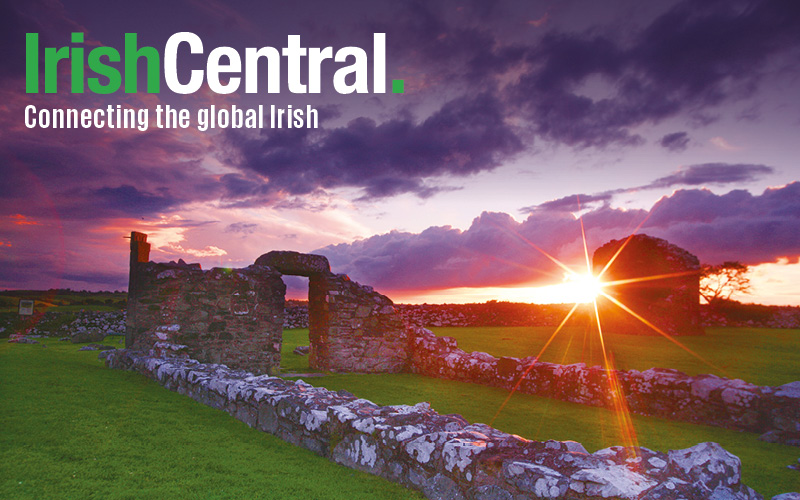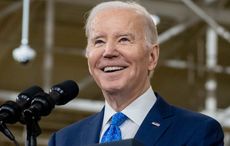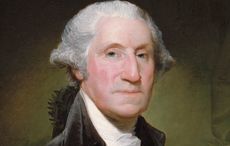On November 30, 1995, US President Bill Clinton made a historic visit to Northern Ireland. Below, Niall O'Dowd recounts the impact of the day.
23 years ago this week Bill Clinton broke an ironclad rule of American diplomacy with a move that led to peace in Northern Ireland.
That rule that stood well over 200 years was that America never interfered in the internal affairs of Great Britain and Ireland was specifically the target of that rule.
For Irish Americans over the centuries no matter their power, that rule had stood. Despite contributing blood and sacrifice in the US Civil War, despite the strength of the Irish vote in the early part of the last century, despite the new Irish Republic in 1921, no president ever gave them a hearing.
Until Bill Clinton.
Here now on a bright Autumn day President Clinton and wife Hillary were descending down the steps from Air Force One at Belfast International Airport.
Ireland would never be the same again.
I vividly remember that moment, one of the highlights of my life. Irish America had finally found its voice and there was nothing surer in my mind but that peace would follow.
Later that day I stood among the 200,000 people crammed into the center of Belfast waiting for President Bill Clinton to appear for the city’s Christmas tree lighting.
While we waited Van Morrison warmed us up on a cold and frosty afternoon with the song “There Will Be Days Like This.”
With perfect hindsight, I can say Van was wrong. There will never be another day like that one.
On the chairs beside me sat Martin McGuinness, Gerry Adams, and Joe Cahill, the leadership of the Irish Republican movement. Not far from me sat David Ervine, Gary McMichael and Gusty Spence, heads of the Loyalist movement.
Adams and the Loyalists had met the American president, an unheard of occurrence. It was clear Clinton was all in.
Once the organizations they headed had been trying to kill each other. Now they were seated feet from each other, making moves for peace thanks in large part to the work of the Irish American president.
Up until that day the notion of an American president in Belfast was fanciful in the extreme, yet here Clinton was. I’ll always remember Martin McGuinness especially, and the disbelief and joy in his eyes, that this day had finally dawned.
If there is ever a day that will stand out in history, this was it. Indeed, it was the greatest day of my journalism career.
I was reminded of the day recently by an excellent article by James Carroll in the Boston Globe remembering the occasion and what the message of the first American president ever to visit Northern Ireland meant to the multitudes.
Interestingly, as Carroll noted, Clinton reached back to the American Civil War.
“I grew up in the American South,” Clinton said. “My forebears were soldiers in the Confederate Army...They lived the experience so many of you have lived.”
And then Clinton recalled the first post-Civil War Arkansas governor, who had fought for the Union.
“We have all done wrong,” Clinton said, quoting a speech the earlier Arkansas governor gave to his constituents, who had been split between the two sides.
“No one can say his heart is altogether clean, his hands altogether pure. Thus, as we wish to be forgiven, let us forgive those who have sinned against us and ours.” Then Clinton drew the lesson: “That was the beginning of American reconciliation, and it must be the beginning of Northern Ireland’s reconciliation.”
Maureen Dowd of The New York Times later wrote that she never saw Clinton happier than that day when he stepped out onto the stage before Belfast City Hall and thousands chanted his name. (Though in the Belfast accent, hilariously, it sounded more like “bull bull” than “Bill, Bill.”)
“In Ireland Mr. Clinton discovered the joys of being a foreign policy president,” Dowd wrote.
And Ireland discovered the incredible potential when American soft power – no troops, no drones, no bombs – was unleashed.
It all seems long ago and far away now, but life for many Irish reached a zenith that December day in Belfast in 1995. America had, at last, stepped into the Irish/British conflict, and peace for the first time had a chance.
When we look at ethnic conflicts all over the world today and the inability to stop them the Clinton intervention in Ireland stands as a beacon of hope.
In the recent release of his oral histories the late Senator Ted Kennedy, a champion of the peace process, gives massive recognition to the role of Bill Clinton and his wife Hillary, who galvanized community groups and women's groups on both sides.
I’m just glad to have had the chance to witness history in the making. Bill and Hillary cut a triumphant swathe from Belfast to Derry back to Belfast and then on to Dublin where he received a rapturous reception. By the end, a deep and irrevocable bond had been forged.
It had all started for Irish Americans and Clinton in January 1992 when, on a cold and damp Monday evening, about two dozen Irish Americans met in the Fitzpatrick Manhattan hotel to create a new organization, Irish Americans for Clinton. The speakers that night were former Congressman Bruce Morrison, myself, and Irish Lobby for Immigration Reform President Ciaran Staunton.
Hotelier John FitzPatrick kindly gave the room gratis. The new organization had no money raised.
The Clinton in question, who many barely knew was a governor of Arkansas, was then considered a long shot for the presidency and even the Democratic nomination for the presidency.
The gathering heard there was to be an ethnic fundraiser for Clinton a month later at the Sheraton Hotel. They hardly seemed impressed.
At the fundraiser itself, the new group scraped together just one table partly made up of visiting Irish students.
Everyone we called was too busy or gave Clinton no chance. It was very tough going. Nowadays a few hundred I’ve met claimed they were there.
The fledgling candidate at that banquet stopped by the table and seemed delighted he had an Irish following.
The dream since Famine times had been to engage an American president on the side of Ireland, not the British. But the Atlantic alliance and special relationship between the US and Britain had proven far too durable a kinship to crack.
Maverick politicians who evinced sympathy for Irish nationalists, such as Congressman Peter King, were untouchable. In a bizarre moment, King, then an elected official, was told by the secret service that he could not meet President Reagan during a visit to Long Island in the early 1980s.
It seemed an even longer shot that the isolation could be breached in 1992. After the first Iraq/Gulf war (the successful one) George Bush Senior looked unbeatable. His ratings were sky-high. His interest in Irish issues was zilch.
During the Bush administration, a group of Irish Americans met with a State Department official overseeing Ireland. The diplomat looked like he had barely started shaving.
He told them his Irish post was merely a function of the country being alphabetically closest to Iceland, a NATO ally and his real interest. As for Ireland, he pulled a batch of Daily Telegraph clippings from his drawer. The notoriously anti-Irish newspaper was his main source of information. The anger in the room was palpable, expressed best by Dr. Bob Lennon of the Irish American Unity Conference, who called the diplomat’s attitude “a complete disgrace.”
Outside on the sidewalk, the sense of despair was evident and the need to find an alternative plan starkly clear.
Leaders in the Irish lobby knew Bush was very unlikely to press for action on Northern Ireland. They were looking for a different kind of candidate and homed in on Clinton among the Democrats.
The Irish soon discovered there was something different about Clinton. Unlike 90 percent of American politicians, he needed no staffers to hand-hold him during discussions.
His time at Oxford University during the birth of the Northern Irish Civil Rights movement in the late 1960s had placed Ireland on his radar forever. Though he was from a state without an active Irish American base, he had followed the history of The Troubles ever since attending Oxford.
He was ready when the Irish came calling.
Clinton spoke at an Irish candidate’s forum night in April 1992 and, most importantly, promised a visa to the U.S. for Sinn Fein leader Gerry Adams, then an international pariah.
Most observers shrugged at the time. Campaigning was different to governing, such a promise would never be fulfilled, they thought. A visa for Gerry Adams was a pipedream.
Later that year, in September, Irish American legend Mayo-born Paul O’Dwyer and I met Clinton at the Sheraton Hotel in Manhattan and came out of the meetings glowing.
O'Dwyer, former New York City Council president, had been meeting with American politicians about Ireland since the 1930s. He’d never met one like this. “He will turn the Irish issue upside down,” he predicted. He never spoke a truer word.
Once in power, Clinton overturned 200 years of British oversight on American policy towards Ireland.
Urged on by a group of Irish American leaders who were intermediaries with Sinn Fein, Clinton jumped on board the Irish bandwagon. The State Department spluttered. Tom Foley, the Anglophile Speaker of the House, objected strongly.
But Clinton, the consummate politician saw something. In January 1994, after a titanic struggle between pro-British and pro-Irish forces, the decision on whether to give Gerry Adams a visa landed on Clinton’s desk.
On the night he had to make the decision he was sandwiched at a dinner between Speaker Foley and Secretary of State Warren Christopher. Both men pounded him on reasons why Adams should not be given a visa.
Clinton, however, was not for turning. Despite the advice of the FBI, CIA, State Department and the British, on January 31, 1994, he gave a visa to Gerry Adams. In the end, the key counterweight was Senator Edward Kennedy, who had decided the Sinn Fein peace outreach was for real.
Clinton’s campaign promise had been fulfilled, and all hell broke loose.
John Major refused to take his calls and the British media lambasted him for it, calling it the greatest insult ever offered a British government. In America, of the major newspapers, only The New York Times approved.
Adams arrived amid a welter of excitement. He spoke at the Waldorf Astoria at an event hosted by Irish American business leader William Flynn and he went on Larry King Live, forcing British authorities to ban the show in Britain.
The Adams move was one of three key triggers that brought about the historic August 1994 IRA ceasefire. The American president’s unorthodox, outside the box maneuver had played a massive role in bringing an end to the violence in Northern Ireland.
He had also proven that the soft power of an American president, when used so brilliantly, could solve a problem so difficult some people even admired its enigmatic nature and pronounced it unsolvable.
Happily, Bill Clinton was not one of those.
To activist Irish organizations, Bill Clinton was a hero and his wife Hillary was not far behind. On their first visit to Ireland, in December 1995, they were feted and celebrated in Belfast, Derry, and Dublin like no one since JFK. Even the British admitted their mistake in opposing the visa.
Hillary too became a committed Irish peace activist. She hosted teas for women from deprived nationalist and loyalist areas. Her Vital Voices conferences gave voice to the North's female leaders, who had never been heard before. She was soon on first name terms with Irish leaders of every stripe.
Down the long years, Hillary gathered a tight group of Irish American supporters around her. One of her last visits as Secretary of State was to Belfast, where she practically pleaded to stay involved post-State.
Ireland and the successes there have meant much to the Clintons, almost as much as they have meant to the American Irish activists, who see in Bill the first American president to step up for their cause. Hilary also has a large share of the reflected glory, which she will no doubt draw on in the 2016 campaign
A small meeting in 1992 at Fitzpatrick’s Hotel culminated in the greening of a US president in a way no one had ever thought possible. We can thank our lucky stars he came along when he did.
*Originally published in 2015




Comments